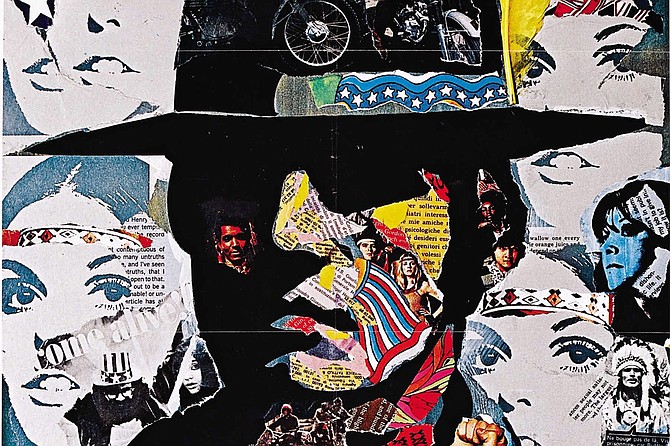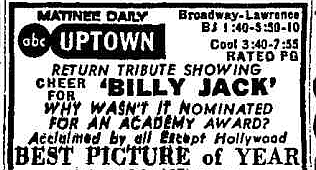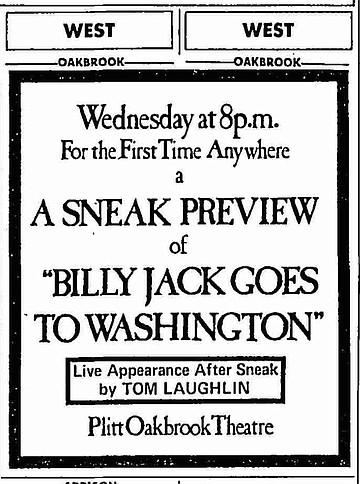 Facebook
Facebook
 X
X
 Instagram
Instagram
 TikTok
TikTok
 Youtube
Youtube

It had been 50 years since Billy and I last met. To say that time had been unkind would be an understatement.
Billy Jack (1971)
Jean Roberts’ (pseudonymous co-writer and Mrs. Tom Laughlin, Delores Taylor) hollow-voiced opening narration brings us up to speed on the legend of Billy Jack. He was a half-breed Vietnam vet who hated what war stood for in spite of adhering to a day-to-day doctrine of “Peace Through Pummeling.” And no one knew where he lived. What Jean fails to tell us is that Billy Jack, not Bruce Lee, deserves credit for introducing American audiences to the martial arts. And woe to those bad guys who refuse to vamoose the moment Billy begins removing his shoes.
It opens just like any low budget anti-western produced around that time, when the windswept dust of the crumbling studio system was so dense it clouded the sun. Sheriff Cole (Clark Howat) rides out to Deputy Mike’s (Kenneth Tobey) place, bringing news of his “kidnapped” daughter’s safe return. Rather than act the role of father to out-of-control daughter Barbara (Julie Webb), sycophantic Mike chooses to join wealthy land baron/poacher Stuart Posner (Bert Freed) on enemy territory to make cash off turning wild mustangs into dog food. Layer in a father-and-son rivalry between macho Posner and his boy Bernard (David Roya), a cowardly sort who refuses the honor of shooting the first wild horse. In addition to the iconic presence of Tobey (Rawhide, Gunfight at the O.K. Corral, A Time for Killing) and Freed (Nevada Smith, Hang ‘Em High, There Was a Crooked Man...), the film was photographed by 70s western accessory Fred Koenkamp (Skin Game, Flap, The Magnificent 7 Ride).
The moment star-pseudonymous-co-writer-producer-director Laughlin appears, one can feel a self-righteous pall being cast over the proceedings. (Billy speaks in platitudes: “When policemen break the law, then there isn’t any law. Just a fight for survival.”) It’s a mood so dominant that all of the subsequent attempts to lighten the load through improvisational humor read like dirges. A little topical humor goes a long way, particularly in these environs. With the exception of one brief skit in which a sports fan is beaten for not standing to sing the National Anthem, the pre-rehearsed spontaneity that Howard Hessman and The Committee bring is at best incongruous, like scenes grafted on from another picture. A fun, party game atmosphere ensues when members of the establishment are invited to visit the school and wing-it in a round of role reversal. It’s harmless enough until credibility is thrown to the wind and Sheriff Cole once again steps out of character, this time to become an honorary participant of the Improv Olympics.
The film was dated the year it came out. Still, two scenes have never left me: Billy going BER-SERK in the diner — the cutaways of Billy’s brow-mopping slow burns are worthy of Brian Keith in TV’s Family Affair — and the subsequent fight scene in the town square. To summon Billy, one does not need to wear a “Zee-Zee”-emitting signal watch or to illuminate the night sky with a Bat (Jack?) signal. Instead, you can contact him “Indian style”: simply want him and he’ll show up. I was 15, and I still remember the two audiences I saw the film with chuckling at the heavy-handed moralizing. What struck me most was Laughlin’s approach to staging a fight scene. Rather than having ten guys gang up on one, they take a number, as if waiting to get served at a deli counter.
The fight concludes at around the thirty-five minute mark with Billy’s bloody defeat. What follows is padding: time spent at Jean’s Freedom School, long-haired weirdos singing anti-war songs, speeches, and a snake ceremony in which Billy is repeatedly bitten. What happens between the beating and the snake ceremony is a blur. All we know is that if Billy survives, he’ll experience a vision that will spell out his life’s mission.
The film was ahead of its time in its depiction of child abuse prevention. When the cops bring Barbara home, her father’s first instinct “is to beat the hell out” of her, particularly upon learning that she was gang-raped while six weeks pregnant. Later, Sheriff Cole, who pretty much comes off as a sympathetic soul, speculates that another beating might not be a bad idea if it would cause her to lose the baby. There’s also the following commendable exchange between Billy and pacifist Jean concerning gun control: “Where’s King? And where’s Bob and Jack Kennedy?” Billy asks. “Dead,” replies Jean. “Not dead,” continues Billy. “Their brains blown out because your people wouldn’t even put the same controls on their guns as they do on their dogs, their bicycles, their cats or their automobiles.”
Critics jeered, audiences cheered: according to The Numbers, budgeted at $800,000, the film’s $98 million take makes Billy Jack the 7th highest grossing western of all-time. But riches weren’t enough for Tom Laughlin. He wanted to be taken seriously as an artist! When the film was brought back a year after its release, newspaper ads screamed, “Why wasn’t it nominated for an Academy Award? Acclaimed by all except Hollywood Best Picture of the Year.” The film was followed in 1974 by the equally successful and, at 170 minutes, even more ponderous sequel, The Trial of Billy Jack.
In the April 22, 1975 issue of Variety, Laughlin took out a full-page ad in the form of a contest in the manner of an open letter. In it, Laughlin went full-on BER-SERK by lambasted critics he accused of being “out of touch with their audience” aka anyone who dared to slight his accomplished prowess behind the camera. He did so by pitting press against the public in the framework of a Billy Jack vs. the Critics Contest with the first prize winner taking home a cool $25,000! Laughlin printed out the 10 best lists on 9 critics asking, “How many of the above are you dying to rush out and see?” Who needs Renoir (The Little Theatre of Jean Renoir), Bunuel (The Phantom of Liberte) Scorsese (Mean Streets), Coppola (The Conversation, The Godfather Part II), Resnais (Stavisky), Altman (Thieves Like Us, California Split) or many more when Laughlin is is prepared to give his audience a pious tongue-flogging they’ll never forget.
Why do critics deride the very pictures their readers most look forward to? Why do outlets employ critics who are so obviously out of touch with their audience? Do negative reviews really impact box office? If Laughlin had spent as much time shaping a narrative as he did trying to legitimize his brand… well, if nothing else, The Trial of Billy Jack would have run an hour shorter. After this, Laughlin had one more Jack left in him, a film that I had the displeasure of seeing in its crudest form: an unfinished, three-plus hour work print minus the musical score and sound effects. The ad promised a personal appearance by Laughlin immediately following the preview. It was a quarter past 11 when the house lights went up and to no one’s surprise, Laughlin was a no-show. Even he must have been appalled at the conceit of transforming Frank Capra’s Mr. Smith Goes to Washington into a Billy Jack sequel. It was a low turnout with the spacious Oakbrook Theatre working at about 20% capacity The evening’s entertainment reached its peak after the show, while rifling through the measly accumulation of comment cards. “I liked it better than self-upuse” (sic) wrote one brave survivor.
The Trial of Billy Jack earned its place in the annals of history by being the first films ever to “open wide.” Prior to its release, films would open in limited run, generally in a well-traveled urban area before hitting the neighborhood screens. For example, when Mary Poppins played the Chicago Theatre, an ad from October 23, 1964 proudly boasted the film, “Will not be shown anywhere else this year within a 300 mile radius of Chicago.” People literally had to drive from miles around to see it. The Trial of Billy Jack opened on 1200 screens making it the widest release of its day. Add to this a 3 million dollar marketing budget and the film not only became one of the year’s top earners, it set the standard for contemporary booking.
As time capsules go, there aren’t too many more entertaining than Billy Jack. Just prepare for a lot of down time to get to the good.





It had been 50 years since Billy and I last met. To say that time had been unkind would be an understatement.
Billy Jack (1971)
Jean Roberts’ (pseudonymous co-writer and Mrs. Tom Laughlin, Delores Taylor) hollow-voiced opening narration brings us up to speed on the legend of Billy Jack. He was a half-breed Vietnam vet who hated what war stood for in spite of adhering to a day-to-day doctrine of “Peace Through Pummeling.” And no one knew where he lived. What Jean fails to tell us is that Billy Jack, not Bruce Lee, deserves credit for introducing American audiences to the martial arts. And woe to those bad guys who refuse to vamoose the moment Billy begins removing his shoes.
It opens just like any low budget anti-western produced around that time, when the windswept dust of the crumbling studio system was so dense it clouded the sun. Sheriff Cole (Clark Howat) rides out to Deputy Mike’s (Kenneth Tobey) place, bringing news of his “kidnapped” daughter’s safe return. Rather than act the role of father to out-of-control daughter Barbara (Julie Webb), sycophantic Mike chooses to join wealthy land baron/poacher Stuart Posner (Bert Freed) on enemy territory to make cash off turning wild mustangs into dog food. Layer in a father-and-son rivalry between macho Posner and his boy Bernard (David Roya), a cowardly sort who refuses the honor of shooting the first wild horse. In addition to the iconic presence of Tobey (Rawhide, Gunfight at the O.K. Corral, A Time for Killing) and Freed (Nevada Smith, Hang ‘Em High, There Was a Crooked Man...), the film was photographed by 70s western accessory Fred Koenkamp (Skin Game, Flap, The Magnificent 7 Ride).
The moment star-pseudonymous-co-writer-producer-director Laughlin appears, one can feel a self-righteous pall being cast over the proceedings. (Billy speaks in platitudes: “When policemen break the law, then there isn’t any law. Just a fight for survival.”) It’s a mood so dominant that all of the subsequent attempts to lighten the load through improvisational humor read like dirges. A little topical humor goes a long way, particularly in these environs. With the exception of one brief skit in which a sports fan is beaten for not standing to sing the National Anthem, the pre-rehearsed spontaneity that Howard Hessman and The Committee bring is at best incongruous, like scenes grafted on from another picture. A fun, party game atmosphere ensues when members of the establishment are invited to visit the school and wing-it in a round of role reversal. It’s harmless enough until credibility is thrown to the wind and Sheriff Cole once again steps out of character, this time to become an honorary participant of the Improv Olympics.
The film was dated the year it came out. Still, two scenes have never left me: Billy going BER-SERK in the diner — the cutaways of Billy’s brow-mopping slow burns are worthy of Brian Keith in TV’s Family Affair — and the subsequent fight scene in the town square. To summon Billy, one does not need to wear a “Zee-Zee”-emitting signal watch or to illuminate the night sky with a Bat (Jack?) signal. Instead, you can contact him “Indian style”: simply want him and he’ll show up. I was 15, and I still remember the two audiences I saw the film with chuckling at the heavy-handed moralizing. What struck me most was Laughlin’s approach to staging a fight scene. Rather than having ten guys gang up on one, they take a number, as if waiting to get served at a deli counter.
The fight concludes at around the thirty-five minute mark with Billy’s bloody defeat. What follows is padding: time spent at Jean’s Freedom School, long-haired weirdos singing anti-war songs, speeches, and a snake ceremony in which Billy is repeatedly bitten. What happens between the beating and the snake ceremony is a blur. All we know is that if Billy survives, he’ll experience a vision that will spell out his life’s mission.
The film was ahead of its time in its depiction of child abuse prevention. When the cops bring Barbara home, her father’s first instinct “is to beat the hell out” of her, particularly upon learning that she was gang-raped while six weeks pregnant. Later, Sheriff Cole, who pretty much comes off as a sympathetic soul, speculates that another beating might not be a bad idea if it would cause her to lose the baby. There’s also the following commendable exchange between Billy and pacifist Jean concerning gun control: “Where’s King? And where’s Bob and Jack Kennedy?” Billy asks. “Dead,” replies Jean. “Not dead,” continues Billy. “Their brains blown out because your people wouldn’t even put the same controls on their guns as they do on their dogs, their bicycles, their cats or their automobiles.”
Critics jeered, audiences cheered: according to The Numbers, budgeted at $800,000, the film’s $98 million take makes Billy Jack the 7th highest grossing western of all-time. But riches weren’t enough for Tom Laughlin. He wanted to be taken seriously as an artist! When the film was brought back a year after its release, newspaper ads screamed, “Why wasn’t it nominated for an Academy Award? Acclaimed by all except Hollywood Best Picture of the Year.” The film was followed in 1974 by the equally successful and, at 170 minutes, even more ponderous sequel, The Trial of Billy Jack.
In the April 22, 1975 issue of Variety, Laughlin took out a full-page ad in the form of a contest in the manner of an open letter. In it, Laughlin went full-on BER-SERK by lambasted critics he accused of being “out of touch with their audience” aka anyone who dared to slight his accomplished prowess behind the camera. He did so by pitting press against the public in the framework of a Billy Jack vs. the Critics Contest with the first prize winner taking home a cool $25,000! Laughlin printed out the 10 best lists on 9 critics asking, “How many of the above are you dying to rush out and see?” Who needs Renoir (The Little Theatre of Jean Renoir), Bunuel (The Phantom of Liberte) Scorsese (Mean Streets), Coppola (The Conversation, The Godfather Part II), Resnais (Stavisky), Altman (Thieves Like Us, California Split) or many more when Laughlin is is prepared to give his audience a pious tongue-flogging they’ll never forget.
Why do critics deride the very pictures their readers most look forward to? Why do outlets employ critics who are so obviously out of touch with their audience? Do negative reviews really impact box office? If Laughlin had spent as much time shaping a narrative as he did trying to legitimize his brand… well, if nothing else, The Trial of Billy Jack would have run an hour shorter. After this, Laughlin had one more Jack left in him, a film that I had the displeasure of seeing in its crudest form: an unfinished, three-plus hour work print minus the musical score and sound effects. The ad promised a personal appearance by Laughlin immediately following the preview. It was a quarter past 11 when the house lights went up and to no one’s surprise, Laughlin was a no-show. Even he must have been appalled at the conceit of transforming Frank Capra’s Mr. Smith Goes to Washington into a Billy Jack sequel. It was a low turnout with the spacious Oakbrook Theatre working at about 20% capacity The evening’s entertainment reached its peak after the show, while rifling through the measly accumulation of comment cards. “I liked it better than self-upuse” (sic) wrote one brave survivor.
The Trial of Billy Jack earned its place in the annals of history by being the first films ever to “open wide.” Prior to its release, films would open in limited run, generally in a well-traveled urban area before hitting the neighborhood screens. For example, when Mary Poppins played the Chicago Theatre, an ad from October 23, 1964 proudly boasted the film, “Will not be shown anywhere else this year within a 300 mile radius of Chicago.” People literally had to drive from miles around to see it. The Trial of Billy Jack opened on 1200 screens making it the widest release of its day. Add to this a 3 million dollar marketing budget and the film not only became one of the year’s top earners, it set the standard for contemporary booking.
As time capsules go, there aren’t too many more entertaining than Billy Jack. Just prepare for a lot of down time to get to the good.


